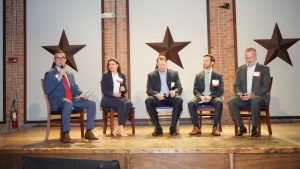Writer: Jerrica DuBois
 3 min read February 2024 — The North Texas business community’s ability to adapt to technology and embrace innovation was a key takeaway from the first panel discussion at the recent Invest: Dallas/Fort Worth Launch Conference.
3 min read February 2024 — The North Texas business community’s ability to adapt to technology and embrace innovation was a key takeaway from the first panel discussion at the recent Invest: Dallas/Fort Worth Launch Conference.
Titled “Innovation & Ingenuity: How banking, professional services and tech are adapting to the present to prepare for the future,” the panel focused on the impact of innovation, the pros and cons of technology in the workplace, and how it can level the playing field for businesses. Chris Clark, partner at FORVIS, Matthew Muns, president of Argano Strategic Industry Group, Buffey Klein, office managing partner at Husch Blackwell, and Jeff Sinnott, CEO of Vantage Bank served on the panel to provide insights.
“We get a bad rep for not being considered innovative,” said Clark while discussing innovation in accounting. “We are finding, as a professional services firm, it’s key to be innovative in creating long term solutions for our clients. FORVIS has created EDGE, which is our innovation lab, where our professionals identify needs our clients have and we have experts that create solutions. We also released Loan Price Pro, which allows bankers to immediately price loans and identify other metrics that help manage client relationships. It’s key for our long term success to make those types of investments and think outside the box of who we are and the type of services we provide to our clients.”
Technology does not only improve the customer service experience, but also internal operations for a company as costs become an increasingly pressing issue. According to IZA World of Labor, there are several benefits to innovation in the workplace, including increased productivity, quality and innovation. It also allows workers to focus more on collaboration and innovation instead of smaller, more mundane tasks. IZA does, however, point out that technology and innovation can cause inequality in the labor market, with less demand for mid-skill workers and increased demand for high-skill workers.
“While people are coming here for our talent base, it also creates a lot of competition for that talent,” said Muns. “If you are a company where everyone has to be located here, working in a plant or office, what we’re looking to help them unleash with digital transformation is automating those little value manual tasks. It allows their people to focus on higher value work, and I think everyone has really embraced it, whether it’s the financial services market, our manufacturing customers, or our aerospace industry here in North Texas.”
It’s not enough just to have the right technology but understand the ways it can benefit overall operations. Companies in the Metroplex, Texas, and across the globe rely on technology and innovation to improve competitive advantage and drive growth.
“We have to understand our clients and how we get service to them that’s cost effective, accurate, and meets our qualifications as an attorney and guiding our client,” said Klein. “AI has a lot of risks. It’s so good that you can’t imagine that it’s not accurate. Our job as counsel is to understand the technology so we can develop systems that will allow for us to use it in an ethical way that gives accurate information to the courts and our clients. We also want to help our clients utilize technology in a way that makes sense for their industry and understand the pitfalls that can occur.”
As the discussion concluded, the focus turned to the elements of innovation that are exciting, or on the other end of the spectrum, that may be cause for concern. The panelists covered the gamut, pointing out the necessity of technology to maintain business, the importance of producing results based on solid data, and the ability of technology to free up more time to focus on clients.
“I believe AI is a great equalizer for our businesses,” said Sinnott. “The most important trend is to digitize and get that data model in a place where you know the source of data, it’s data that is successful and you can use it across your industry and your work flows. I’m a big believer of technology, AI and these resources to equalize the different sizes of our businesses. The smaller businesses could be more agile, and they could have better data models. If they have better data models, they can leverage data today and well into the future.”
For more information, visit:

